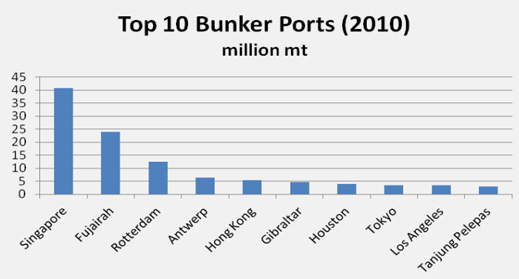
By John Helmer, Moscow
Gazprom, Russia’s largest company, has announced a plan to supply liquefied natural gas (LNG) it isn’t producing to terminals piping ship fuel into a fleet of vessels which the Summa Capital group, directed by Ziyavudin Magomedov, would like to operate — only they don’t exist either. The scheme is more environmentally friendly than any in Russian naval history, only it is a fiction. Why?
The official announcement appeared in Moscow on September 20. Gazprom and Summa Group had signed a Memorandum of Understanding (MoU), the announcement said, “fix[ing] the intentions of the parties to arrange cooperation for LNG utilization as a bunker fuel for marine vessels, including those owned and operated by Summa Group. In the first instance, Gazprom Group and Summa Group will consider the possibility of cooperation in the North Sea and the Baltic Sea regions. Apart from LNG supplies for Summa Group needs, the parties will consider potential development of the bunkering infrastructure in the North and Baltic Seas, particularly LNG storage facilities.”
According to Gazprom’s release, “the tough mandatory restrictions on emissions for marine vessels, carrying out transportation operations in the Baltic and North Seas, to be imposed after 2015 is the most important factor of switching to alternative fuel. LNG is the only fuel that meets the requirements.” Technically, this isn’t quite right. Low-sulphur fuel oil can be supplied to ships to meet the new standard, only it is likely to cost much more than LNG-based fuel.
Summa, part-owner of the Novorossiysk and Primorsk ports, was asked to clarify what vessels it currently owns, or plans to acquire; what it estimates to be the value of the LNG-based bunker fuel market in the Baltic Sea basin; and what infrastructure must be built, where, and at what cost to implement the MoU. Summa spokesman, Alexei Daletskiy, told Fairplay the company has “no comment”. That’s an admission that while a fleet of ocean-going vessels, powered by LNG bunker fuel, may be a gleam in Magomedov’s eye, there is no such fleet now, and no money to build one.
Magomedov is the controlling shareholder and chairman of Novorossiysk Commercial Seaport Company (NCSC), which in turn operates the ports of Novorossiysk on the Black Sea, Primorsk oil terminal on the Gulf of Finland, and a terminal at Kaliningrad on the Baltic Sea. Disclosures in the NCSC Eurobond prospectus, issued in May 2007, revealed a fleet of 28 tugboats operating at Novorossiysk, plus firefighting, oil spill clean-up and other auxiliary vessels. The fleet of tugs and auxiliaries at Primorsk and Kaliningrad add to this number. But all of them are conventionally powered and conventionally fuelled ships. Not a whiff of LNG within several thousand kilometres.
Gazprom operates only one LNG plant in Russia, and that is at Aniva Bay, on Sakhalin island in the fareast. All of its current output is sold on long-term contract to buyers in South Korea and Japan.
Also, there is no current plan for Gazprom to build an LNG plant in western Russia. If anyone builds a western Russian LNG plant, it is likely to be Gazprom’s domestic rival, Novatek, in partnership with Total of France. The last Gazprom plan to produce LNG in western Russia has been suspended because the Shtokman gasfield project in Barents Sea has been postponed indefinitely. There are other Russian LNG projects, but they too are gleams in other entrepreneurs’ eyes, and no closer to realization than Shtokman.
So where will the LNG come from for Summa’s proposed fleet, or for the Baltic bunker fuel terminal Summa is proposing to build, Gazprom was asked. Spokesman Ivan Adriyanov told Fairplay it “is too early to say.” He added there is no intention of doing anything about the LNG-bunker idea until 2016 at the earliest.
This timing is significant, because of the introduction of new emission standards for ocean-going vessels. What happens in 2015 is that emission control areas (ECAs) will be implemented to regulate the allowable amount of sulphur in fuel which ships burn as they power through the sea, off northern European coastlines. The sulphur content is to be reduced to one-tenth of the current limit. To comply, either ship owners will have to pay substantially more for low-sulphur bunkers (ship fuel), or else they will have to build new ships whose engines have been designed to operate with LNG. Right now these new ships are gleams in shipbuilder eyes, although Norway is operating prototypes, and there are many shipyard designs on offer.
For the time being too, no Russian oil port makes the top-10 in global bunker ports:

Adding LNG pipelines to deliver and store LNG bunkers ashore, construct new LNG bunker barges to load ships, and redesign and build a new type of LNG bunker powered fleets is expensive. Much too expensive for Summa, even in combination with Gazprom. Summa has been making much this year of its plan to invest in new oil terminal facilities at Rotterdam since last October, but these contemplate shipment of Urals crude from Primorsk to Rotterdam, not LNG from thin air.
Even if the Rotterdam master plan anticipates offering LNG bunker fuel, there is no foreseeable way Gazprom can supply it. As far as realistic timing goes, this discussion of bunker fuel and fleet experts concludes that a significant shift to LNG fuelled ships isn’t likely outside Russia before 2025.
So why have Gazprom and Summa combined to promote an idea with such improbable prospects? One of Russia’s leading tanker experts responds: “It’s absolutely unrealistic. Someone at Gazprom has been having fantasies, and saying them aloud.”











Leave a Reply